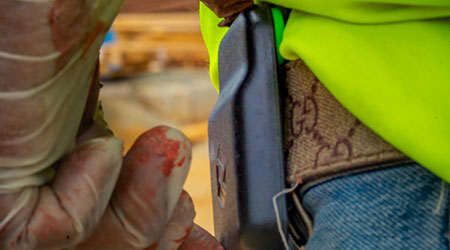According to an industry article, in 2018, a dozen hospitals and health systems announced or unveiled facility expansions and renovations with price tags of $1 billion or more – and, according to another trade publication, there’s currently about $400 billion in healthcare construction underway around the world.
Construction renovation projects seem to be on the rise at hospitals across the country for several reasons. With state-of-the-art facilities, hospitals can more effectively compete in a growing marketplace; better meet patient satisfaction; attract world-class doctors; and stay current with codes and regulations.
Whatever the reason, renovations at hospitals and other healthcare facilities are boosting the capacity and capabilities of health systems, yet they can result in a number of challenges on the construction jobsite.
Any construction project can be an inherently challenging environment to work in, with heavy materials, machinery and equipment, a transient workforce and many different projects taking place at once. Yet, the hospital construction site poses a whole new set of challenges, since patient care is 24/7 and can’t be interrupted due to construction. And, since hospital renovations can be disruptive to hospital operations, contractors are often under pressure to complete the project under reduced timelines.
Despite the need to be efficient and minimize disruption as much as possible, of paramount concern is the need to ensure safety and security – of workers, patients and the public. To help address these concerns, many contractors are turning to Internet of Things (IoT) technologies that will not only enable them to operate more efficiently, but also to reduce safety risk.
Boosting site safety, security
When workers are equipped with IoT-based wearable sensors, managers can see in real time the workers present for every trade (plumbing, electrical, etc.) and where they are located on site. When combined with access control technologies, these wearable IoT devices can serve as the only credential workers need on site. They can ensure compliance with regulations by granting entry only to workers with up-to-date training and certifications as well as authorization to be on site.
Contractors can further promote safety by placing IoT sensors on equipment, such as forklifts, that can communicate with workers’ devices to help ensure awareness that only those who have the proper credentials are using them.
In the event that a safety incident does occur, every second matters when it comes to getting help to the worker. There are wearable sensors available today that can alert safety personnel to falls in real-time so they can get help to the scene faster and potentially reduce or limit the severity of injuries. Workers also have the ability to utilize push buttons on these devices to send immediate notifications to supervisors of injuries or unsafe working conditions, enabling workers to take control over their site safety culture.
Additionally, in the event of evacuation, sensors can not only alert each worker no matter where they are on site, but they also can enable managers to see where workers are so they can make sure everyone gets out and can direct emergency responders to a worker’s last-known location.
Managing the moving parts on the jobsite
IoT technology is also solving a critical need to help contractors keep track of, and effectively manage, the many moving parts on a jobsite – people, equipment, tools and more.
Because wearables and IoT sensors can monitor where these resources are in real-time they can help contractors improve productivity. For example, by putting sensors on equipment and tools, contractors can reduce the time wasted in tracking them down. This is a sorely needed capability considering that an average construction worker spends about 20 percent of his/her time waiting for materials, equipment or information, according to a study by the Department of Construction Science and Management at Clemson University.
Pete Schermerhorn is President and CEO of Triax Technologies.

 UF Health Hospitals Rely on Green Globes to Realize Their Full Potential
UF Health Hospitals Rely on Green Globes to Realize Their Full Potential How Healthcare Facilities Can Be Truly Disaster-Resilient
How Healthcare Facilities Can Be Truly Disaster-Resilient TriasMD Breaks Ground on DISC Surgery Center for San Fernando Valley
TriasMD Breaks Ground on DISC Surgery Center for San Fernando Valley Bigfork Valley Hospital Falls Victim to Data Breach
Bigfork Valley Hospital Falls Victim to Data Breach AI-Driven Facilities: Strategic Planning and Cost Management
AI-Driven Facilities: Strategic Planning and Cost Management